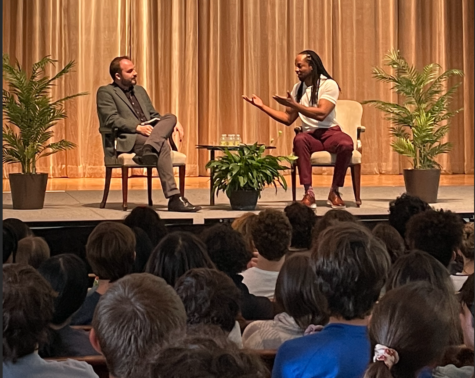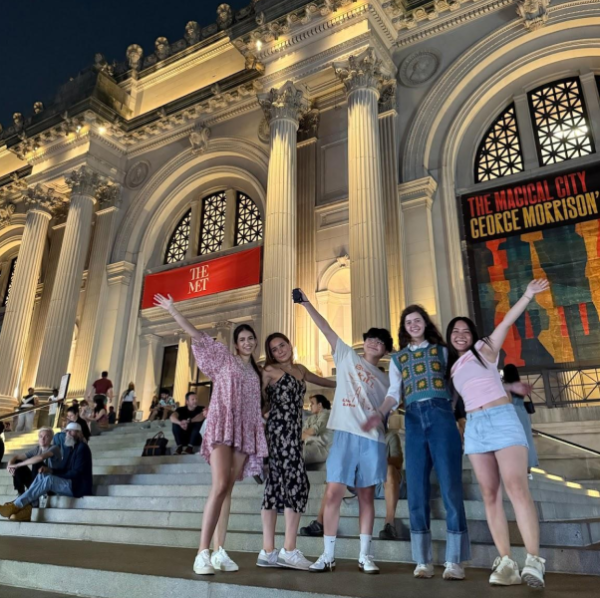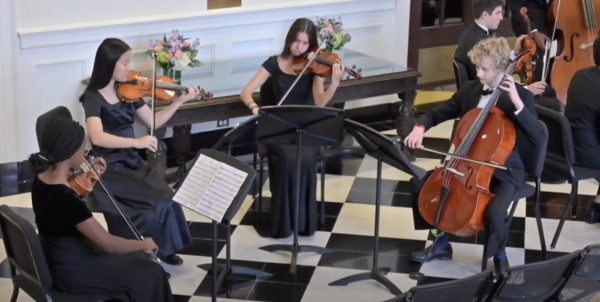Jericho Brown visits Westminster
“A poem is a gesture toward home.”
At least it is according to Pulitzer Prize winning poet Jericho Brown, who visited Westminster on Oct. 13, 2022. Brown has published three collections of poetry—Please, New Testament, and The Tradition—all of which won him accolades, with The Tradition winning the esteemed 2020 Pulitzer Prize for Poetry.
From 1:10 to 1:50 p.m., Westmisnter’s classes of 2023 and 2024 listened to a conversation between Brown and Upper School English teacher Mario Chard in McCain Chapel. The two discussed Brown’s journey of becoming a poet, his inspirations, and the meanings behind a few select poems.

Brown grew up surrounded by poetry, spending hours reading countless poems at the library while his mother completed her day’s work as a librarian. By age 10, he decided that he would take poetry for his career. In college, he had the opportunity to talk with poet Gwendolyn Brooks, the first African American person to win a Pulitzer Prize, who offered Brown guidance on his desired occupation. Although Brown had not published many works yet, Brooks conversed with Brown as if he were already an established poet. The conversation inspired Brown and further expanded his passion for poetry.
Brown also read a few of his poems aloud to Westminster’s junior and senior classes. “The Trees” illustrates his love for the three crepe myrtles standing resolutely in his front yard. He notices their transformation as the seasons change: they provide soothing shade in summer yet grow bare in winter. Despite this, he appreciates what reliability and consistency they hold: “A crepe myrtle is / A crype myrtle.”
“I think the last two lines are really insightful,” said senior Mason Yu. “‘It’s not that I love them / Every day. It’s that I love them anyway.’ He loves the trees no matter what phases they go through. It ends the poem on a positive note.”
Through his poem, Brown reveals his appreciation for seemingly minute details of his trees—the same ones he sees every day from his living room window. Through this appreciation, he loves them: those beautiful crepe myrtles.
Although he touched on it briefly during his 1:10 p.m. talk, Brown discussed his poetry writing process more in depth during his 11:00 a.m. talk with AP English Language students in Warren Lecture Hall. A key point from the talk was Brown’s ability to find inspiration for poems in everyday life; while completing mundane tasks like washing the dishes or taking out the trash, he often begins his thoughts with “I wonder…”
He once asked himself the question, “I wonder: is it possible to write a poem with only repetition?” He reflected on repetitions in hymns—despite the fact that some hymns consist of only one unique line, the hymns’ melodies generate nuance in the same line’s meaning.
“Poems are more life-like depending on where you are; they are like amethyst,” said Brown.
Furthermore, a single line could hold multiple interpretations at the same time and in the same melody. With this thought in mind, Brown focused on expressing a sense of “at onceness” in his poem.
“I am at once one-hundred percent my mother’s son, one-hundred percent a brother, etc.,” said Brown. He, a single person, could simultaneously encapsulate the character of all of these things he mentioned. Similarly, his lines could also hold this multifaceted nature of values.
Brown considered combining three forms of poetry together to create a poem centered on repetition, one of which was the ghazal form. He also drew inspiration from sonnets, due to their classical and widespread fame, and blues, poems of African American origin which focused on topics of despair and struggle, to reflect in his own work.
After Brown wrote his first line, he followed a simple rule: when a related idea came to his mind based on the previously written line, Brown intentionally skipped writing it down and instead wrote the next idea in order to adapt that second thought into the next line of poetry. In doing so, he created poetry whose consecutive lines surprise the reader, piquing their interest.
After following his original ideas and his special poetry-writing technique, Brown had invented a new form of poetry. By marrying ghazals, sonnets, and blues, he created the first duplex, a poem consisting of seven couplets and focusing on repetition.
One couplet in his first duplex titled “Duplex” reads, “Light rain hits easy but leaves its own mark / Like the sound of my mother weeping again.” The duplex holds the motif of permanent marks. Despite their varying origins, all marks—physical or emotional, light or hard—sting painfully.
Just as individual lines are paired in couplets in a duplex, two duplexes—“Duplex” and “Duplex: Cento”—are matched in Brown’s most recent poetry collection, The Tradition. The two duplexes discuss similar topics, emphasizing the importance of repetition within Brown’s poems.
Brown reminded the audience that, despite his current standing as a professional poet and Pulitzer Prize winner, starting a piece still sometimes poses a challenge. He recommends that writers struggling with this problem should embrace their current mindset and just write. He also encourages writers to “be playful” with their first draft, as writers will always have a chance to revise their work.
“Go more towards music and away from set norms,” Brown recommends. That way, writers can write more creatively, originally, and impactfully.
Edited by Alexandra Kent





